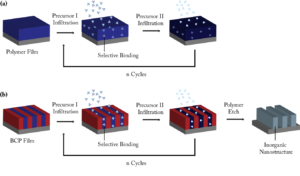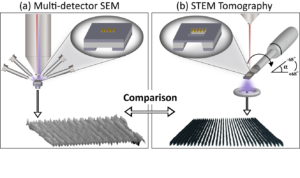1. Developing sequential infiltration synthesis (SIS) as a new platform for precise fabrication of hybrid organic-inorganic materials and inorganic nanostructures
Sequential infiltration synthesis (SIS) is an emerging technique for growth of inorganic materials within polymers using vapor precursors and atomic layer deposition chemistry. It enables to modify existing polymer structures (thin films, polymer fibers, self-assembled block copolymer nanostructures, etc.) into hybrid materials through precise, step-by-step growth of inorganic materials within the polymer volume. Through SIS, polymer properties such as mechanical, thermal, and electronic properties can be tuned. In addition, SIS can be used for simple fabrication of inorganic nanostructures. The polymer serves as a defining volume for the inorganic materials growth. Upon removal of the polymer, inorganic nanostructure is formed, templated by the polymer morphology. In FNAI, we study many aspects of SIS: we develop new SIS chemistries, study the mechanism of SIS, and develop new pathways for nanofabrication of functional nanostructures.

Published papers:
- B. K. Barick, A. Simon, I. Weisbord, N. Shomrat, T. Segal-Peretz, Tin oxide nanostructure fabrication via sequential infiltration synthesis in block copolymer thin films, Journal of Colloid and Interface Science, 2019, 557, 537-545.
- I. Weisbord, N. Shomrat, H. Moshe, A. Sosnik, T. Segal-Peretz, Nano spray-dried block copolymer nanoparticles and their transformation into hybrid and inorganic nanoparticles, Advanced Functional Materials, 2020, 30, 1808932.
- R. Azoulay, N. Shomrat, I. Weisbord, G. Atiya, T. Segal-Peretz, Metal oxide heterostructure array via spatially controlled-growth within block copolymer templates, Small, 2019, 15, 1904657.
- Weisbord, N. Shomrat, H. Moshe, A. Sosnik, T. Segal-Peretz, Nano spray-dried block copolymer nanoparticles and their transformation into hybrid and inorganic nanoparticles, Advanced Functional Materials, 2020, 30, 1808932.
- Golany, I. Weisbord, M. Abo Jabal, O. Manor, T. Segal-Peretz, Polymer dewetting in solvent-non-solvent environment- new insights on dynamics and patterning, Journal of Colloid and Interface Science, 2021, 596, 267.
- K. Barick, N. Shomrat, U. Green, Z. Katzman, T. Segal-Peretz, Fabrication of nanoscale oxide textured surfaces on polymers, 2021, Polymers, 13, 2209.
- Azoulay, M. Barzialy, I. Weisbord, R. Avrahami, E. Zussman, T. Segal-Peretz, Sequential infiltration synthesis for high-precision fabrication of applied ceramic fibers with designed nanostructures- nanowires, nanobelts, and core–shell fibers, 2022, ACS Applied Nano Materials, 5, 7228.
2. Atomic layer processes for enhancing water filtration and separation technologies
At the FNAI Lab, we explore the many ways in which atomic layer processing techniques can be used to impact and improve membrane applications and membrane imaging. Sequential infiltration synthesis (SIS) is used to modify specific components of polymer composites and block copolymer structures. We can selectively transform polymer materials into hybrid inorganic-organic material with unique mechanical and chemical properties. Atomic layer deposition (ALD) is a powerful way to modify membrane surfaces and tune pore sizes. We utilize ALD to impact selectivity and explore antifouling properties as well as to reduce scaling. Molecular layer deposition (MLD) is a subcategory of ALD and can be used to create polymer thin films. We use MLD to create selective membrane films layers with nanoscale precision.

Published papers:
- C. Zhou, T. Segal-Peretz, M. E.Oruc, H. S. Suh, G. Wu, P. F. Nealey, Fabrication of nanoporous alumina ultrafiltration membrane with tunable pore size using block copolymer templates, Advanced Functional Materials, 2017, 1701756.
- T. Itzhak, N. Segev, A. Simon, V. Abetz, G. Ramon, T. Segal-Peretz, ALD for gradient surface modification and controlled hydrophilization of ultrafiltration polymer membranes, ACS Applied Materials and Interfaces, 2021, 13, 15591.
- Z. Zhang#, A. Simon#, C. Abetz, M. Held, A. Höhme, E. S.Schneider, T. Segal-Peretz, Volker Abetz, Hybrid Organic-Inorganic-Organic Isoporous Membranes with Tunable Pore Sizes and Functionalities for Molecular Separation, 2021, Advanced Materials, 2105251.
- A. Simon Z#, Z. Zhang#, C. Abetz, V. Abetz, T. Segal-Peretz, Atomic layer deposition enables multi-modal three-dimensional electron microscopy of isoporous membranes, 2023, Nanoscale, Accepted.
3. Atomic layer processes for renewable energy harvest and storage
Our research explores how atomic layer deposition (ALD) and sequential infiltration synthesis (SIS) can be used to improve energy harvest devices (such as thermoelectric materials) and energy storage devices (such as new rechargeable metal-based batteries). The high precision and nanoscale structures fabricated by ALD and SIS processes, enable new control over the properties of these devices.

4. Enhancing conventional polymers and recycable biopolymer properties and durability
Our research harnesses atomic layer processing (ALD, MLD, & SIS) to create new interfaces in conventional polymers and biopolymers. Engineering the external interface of polymers with organic or inorganic coatings, or by creating a hybrid organic-inorganic interfaces, can improve the polymer durability under various environments as well as create a new interface susceptible for additional chemical modifications with new functionalities.

5. 3D imaging of nanoscale structures using electron microscopy
The FNAI group specializes in 3D characterizations in the nanometric scale. In many applications, understanding the 3D structure is critical in the transition from idea to functioning device. The 3D morphology and/or defects could be responsible for failure in electrical devices, for reduced performance in filtration systems, etc.. Fully understanding how they are formed and what their structure is, is a vital step in many nanometric applications, and particularly in block copolymer (BCP) self-assembly. This knowledge is most often gleaned from electron microscopy, which allows us to gain deep understanding of nanostructures, including statistical analysis and study of defects. Using electron microscopy we’ve been able to study block copolymer self-assembly, hybrid organic-inorganic and fully inorganic structures, including preforming elemental analysis to probe spatial metal oxide growth inside BCPs, using combined transmission electron microscopy (TEM) – energy dispersive x-ray spectroscopy (EDX) tomography, scanning TEM tomography, and even characterize membrane pores structure using focused ion beam-scanning electron microscopy tomography.

Published papers:
- K. Barick, N. Shomrat, U. Green, Z. Katzman, T. Segal-Peretz, Fabrication of nanoscale oxide textured surfaces on polymers, 2021, Polymers, 13, 2209.
- Segal-Peretz, J. Winterstein, M. Doxastakis, A. Ramirez-Hernandez, M. Biswas, J. Ren, H. S. Suh, S. B. Darling, J. A. Liddle, J. W. Elam, J. J. de Pablo, N. Zaluzec, and P. F. Nealey, Characterizing the three-dimensional structure of block copolymers via sequential infiltration synthesis and scanning transmission electron tomography, ACS Nano, 2015, 9 (5), 5333-5347.
- Weisbord, N. Shomrat, H. Moshe, A. Sosnik, T. Segal-Peretz, Nano spray-dried block copolymer nanoparticles and their transformation into hybrid and inorganic nanoparticles, Advanced Functional Materials, 2020, 30, 1808932.
- Azoulay, N. Shomrat, I. Weisbord, G. Atiya, T. Segal-Peretz, Metal oxide heterostructure array via spatially controlled-growth within block copolymer templates, Small, 2019, 15, 1904657
- Shomrat, K. Chirko, I. Weisbord, Y. Avniel, S. Khristo, D. Nessim, A. Litman, T. Segal-Peretz, Development and evaluation of three-dimensional metrology of nanopatterns using electron microscopy, 2022, Journal of Micro/Nanopatterning, Materials and Metrology, 21, 021202.
- Simon Z #, Z. Zhang #, C. Abetz, V. Abetz, T. Segal-Peretz, Atomic layer deposition enables multi-modal three-dimensional electron microscopy of isoporous membranes, 2023, Nanoscale, accepted.